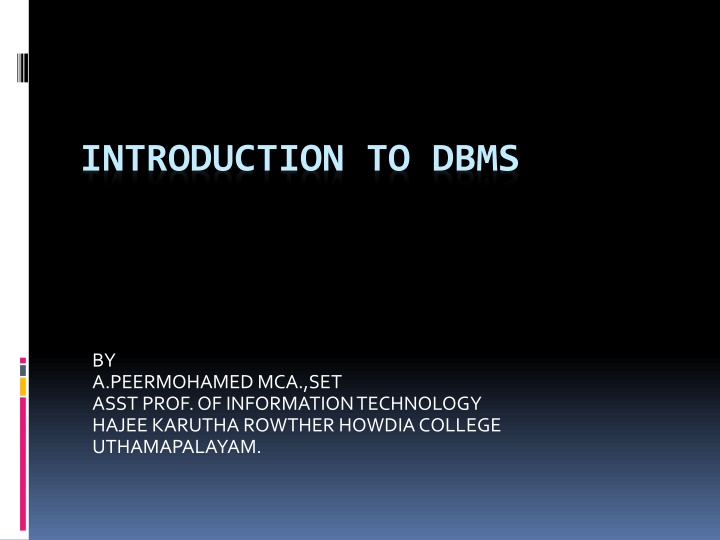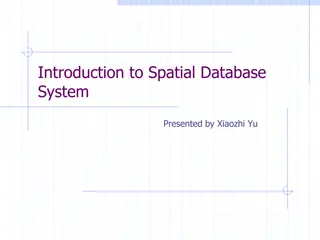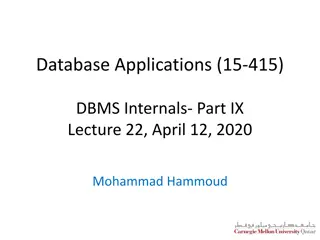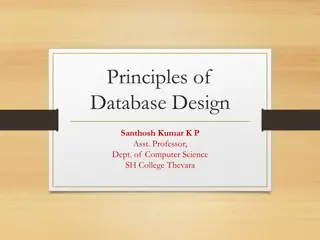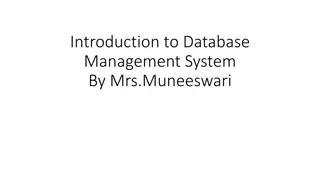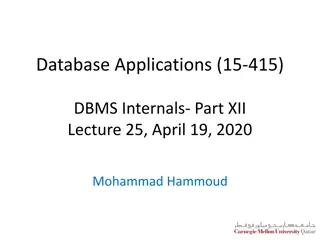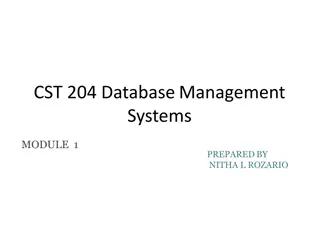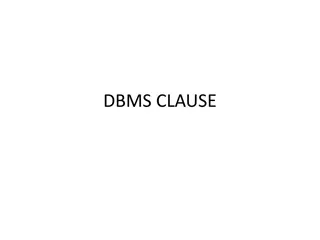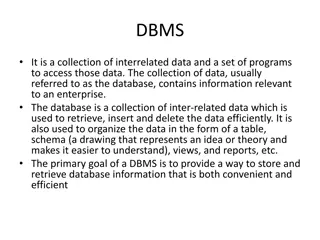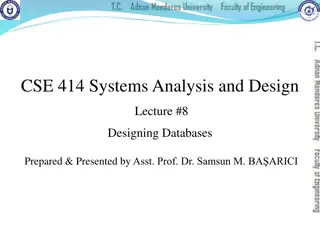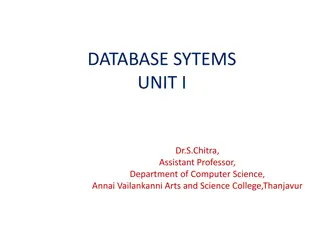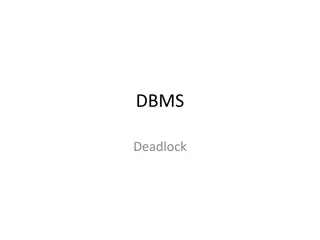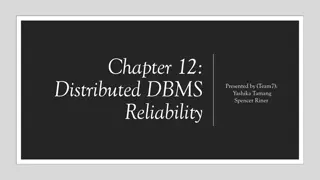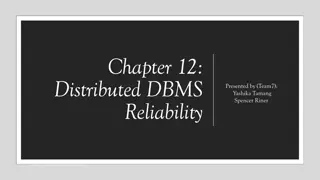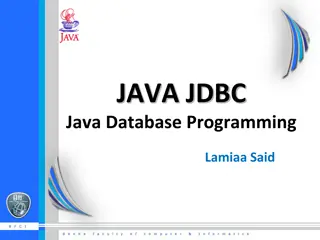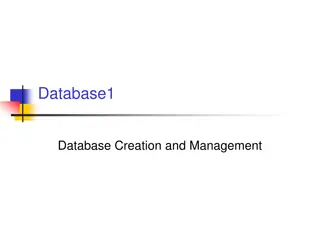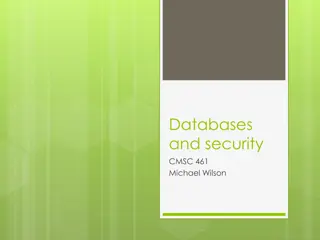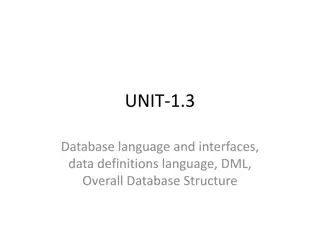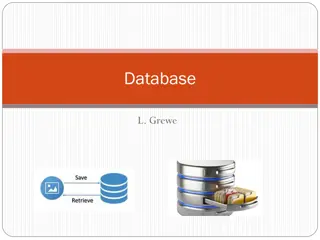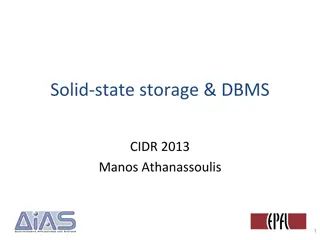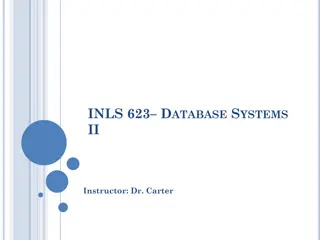Database Management Systems (DBMS): A Comprehensive Overview
This comprehensive overview of Database Management Systems (DBMS) covers the definition, environment, advantages, limitations, and characteristics of data in a database. It delves into the hardware and software components, user roles, and benefits of using a DBMS. The content highlights the control of redundancy, data consistency, security features, and economy of scale afforded by a DBMS while also addressing its limitations such as complexity and vulnerability. Additionally, it emphasizes the importance of maintaining data integrity, sharing data efficiently, and ensuring secure access to information within a centralized database environment.
Download Presentation

Please find below an Image/Link to download the presentation.
The content on the website is provided AS IS for your information and personal use only. It may not be sold, licensed, or shared on other websites without obtaining consent from the author.If you encounter any issues during the download, it is possible that the publisher has removed the file from their server.
You are allowed to download the files provided on this website for personal or commercial use, subject to the condition that they are used lawfully. All files are the property of their respective owners.
The content on the website is provided AS IS for your information and personal use only. It may not be sold, licensed, or shared on other websites without obtaining consent from the author.
E N D
Presentation Transcript
INTRODUCTION TO DBMS BY A.PEERMOHAMED MCA.,SET ASST PROF. OF INFORMATION TECHNOLOGY HAJEE KARUTHA ROWTHER HOWDIA COLLEGE UTHAMAPALAYAM.
CONTENTS DEFINITION DBMS ENVIRONMENT ADVANTAGES OF DBMS LIMITATIONS OF DBMS CHARACTERISTICS OF DATA IN DATABASE TYPES OF DBMS
DEFINITION A collection of self-describing and integrated data files System catalog Meta data Data dictionary Overhead data Data abstraction
DBMS Environment Hardware Client-server architecture Software dbms, os, network, application Data Schema, subschema, table, attribute People Data administrator & database administrator Database designer: logical & physical Application programmer End-user: naive & sophisticated Procedure Start, stop, log on, log off, back up, recovery
Advantages of DBMS Control redundancy Consistency Integrity Security Concurrency control Backup & recovery Data standard More information Data sharing & conflict control Productivity & accessibility Economy of scale Maintenance
Limitations of DBMS Complexity Size Cost Software Hardware Conversion Performance Vulnerability
CHARACTERISTICS OF DATA IN DATABASE The data in the database possess several characteristics data in the database are consistent, integral, non redundant, secured, centrally managed and shared among multiple applications. There are sever advantages of using database approach, such as the following:
Contd.. There are sever advantages of using database approach, such as the following: Single repository of data is maintained All users access the data from the same resource Quick retrieval of data Reduce application development time Flexibility in change of database structure Enforce standardization Up-to-date information availability Authorized access security of data Enforce integrity constraints and business rules Provide backup and recovery procedure
Types of Database Management Systems Hierarchical databases Network databases Relational databases Object-oriented databases
Hierarchical databases In a hierarchical database management system (hierarchical DBMSs) model, data is stored in a parent-children relationship node. In a hierarchical database, besides actual data, records also contain information about their groups of parent/child relationships. In a hierarchical database model, data is organized into a tree-like structure. The data is stored in the form of a collection of fields where each field contains only one value. The records are linked to each other via links into a parent-children relationship. In a hierarchical database model, each child record has only one parent. A parent can have multiple children. To retrieve a field s data, we need to traverse through each tree until the record is found.
Advantage A hierarchical database can be accessed and updated rapidly. As shown in the figure above, its model structure is like a tree and the relationships between records are defined in advance. This feature is a double-edged sword.
Disadvantage This type of database structure is that each child in the tree may have only one parent. Relationships or linkages between children are not permitted, even if they make sense from a logical standpoint. Hierarchical databases are like this in their design. Adding a new field or record requires that the entire database be redefined.
Network Database Network database management systems (Network DBMSs) use a network structure to create a relationship between entities. Network databases are mainly used on large digital computers. Network databases are hierarchical databases, but unlike hierarchical databases where one node can have a single parent only, a network node can have a relationship with multiple entities. A network database looks more like a cobweb or interconnected network of records. In network databases, children are called members and parents are called occupiers
Advantages Conceptual simplicity Capability to handle more relationship types. Ease of data access Data integrity Data independence
Disadvantages System Complexity Absence of structural independence.
Relational Databases In a relational database management system (RDBMS), the relationship between data is relational and data is stored in tabular form of columns and rows. Each column of a table represents an attribute and each row in a table represents a record. Each field in a table represents a data value. Structured Query Language (SQL) is the language used to query RDBMS, including inserting, updating, deleting, and searching records. Relational databases work on each table that has a key field that uniquely indicates each row. These key fields can be used to connect one table of data to another.
Advantages Relational databases can be used with little or no training. Database entries can be modified without specifying the entire body
Disadvantages Hardware overheads. Ease of design can lead to bad design. Information Island phenomenon.
Object-Oriented Model In this Model, we have to discuss the functionality of object- oriented Programming. It takes more than the storage of programming language objects. Object DBMS's increase in the semantics of C++ and Java. It provides full-featured database programming capabilities while containing native language compatibility. It adds the database functionality to object programming languages. This approach is analogical of the application and database development into a constant data model and language environment. Applications require less code, use more natural data modeling, and code bases are easier to maintain. Object developers can write complete database applications with a decent amount of additional effort.
Advantages Capability to handle large numbers of different data types. Marriage of object oriented and database technology. Object oriented improves productivity- inheritance. Data Acess
Disadvantages Difficult to Maintain Not suited for all applications.
